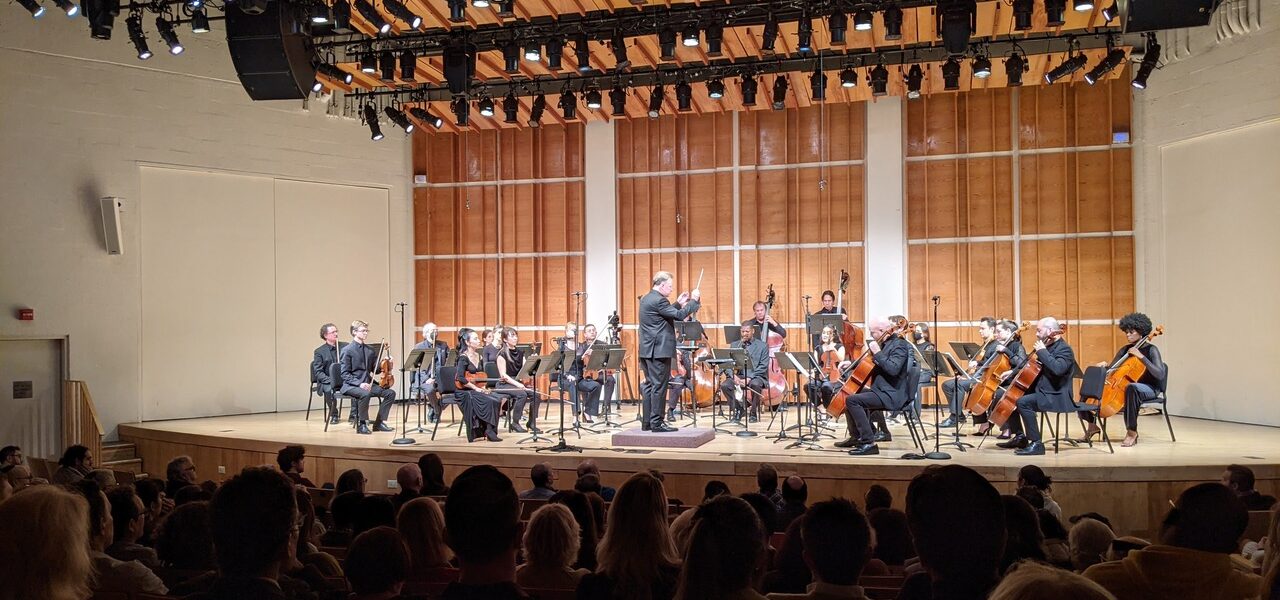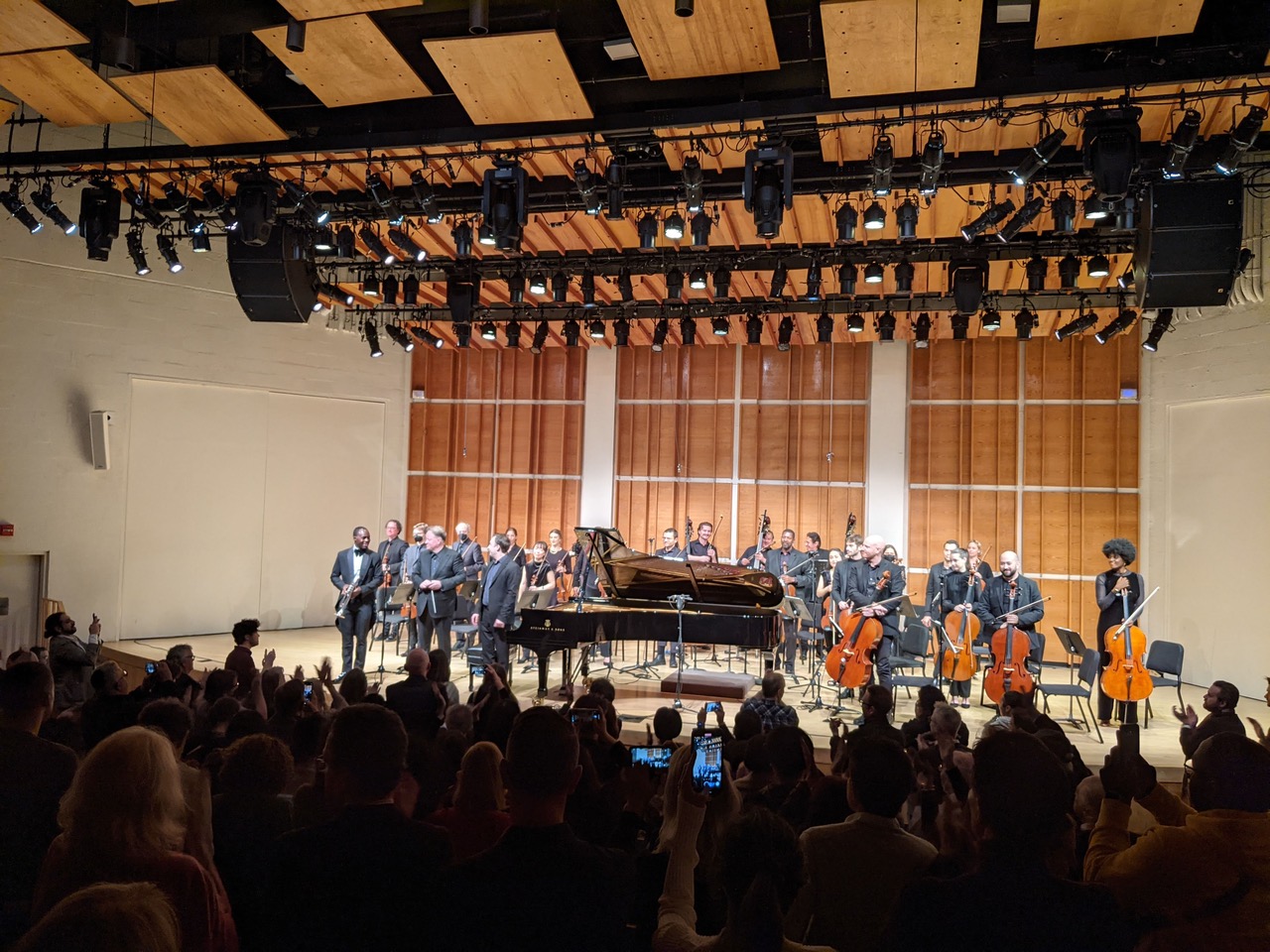The Strings of Modus Operandi Orchestra in Review
Justin Bischof, conductor
Alexandre Moutouzkine, piano; Eganam Segbefia, trumpet
Merkin Hall, Kaufman Center, New York, NY
November 30, 2022
On a cold and rainy evening at Merkin Hall, The Strings of Modus Operandi Orchestra offered an excellent program, with works from Dmitri Shostakovich, Richard Strauss, and rising star Jessie Montgomery (b. 1981). Those who braved the bad weather and early start time (and there were many, including a large contingent of very enthusiastic Manhattan School of Music students) were witness to masterful music-making in outstanding performances.
Before I get into the review proper, I must bring up (again!) the issue of program notes. The printed materials gave very generous space to the organization and the featured artists, but only a few lines about the Jessie Montgomery works and not a word about the Shostakovich or Richard Strauss works. The historical background of these works is key in the understanding of them, and, especially with Shostakovich, there are clear biographical connections. To omit any mention is at best negligent and at worst inexcusable. Part of the concert experience is to educate – and yet another opportunity to do so is lost. Give brief summaries of the artists, with web addresses for further reading, and save some space for the composers and their works.
Conductor Justin Bischof took the stage and welcomed the audience. He spoke a bit about Jessie Montgomery (who had played in the Modus Operandi Orchestra) and how delighted he was to be offering two of her works, Starburst and Strum. Even those these works were not played consecutively, I’m going to discuss them together. These short works (approximately three and seven minutes respectively) are a welcome addition to any concert. There is witty interplay, driving rhythmic vitality, and just enough stridency to underscore the thematic material without ever losing a sense of tonality. After hearing these works, it is easy to see why Ms. Montgomery’s star is on the rise – she is a highly skilled composer that writes in an extremely accessible manner that is not derivative or self-conscious. Played with unabashed enthusiasm, it was a very enjoyable start to the evening.
Dmitri Shostakovich’s Chamber Symphony, Op. 110a followed Starburst. The Chamber Symphony is an arrangement of his Eighth String Quartet, Op 110, by Rudolf Barshai, one of the founders of the Borodin Quartet and long-time conductor of the Moscow Chamber Orchestra. Barshai wrote “When I finished the score, I showed it to him (Shostakovich). He liked it very much, and with his own sense of humor and exuberance, he shouted: ‘Well, that sounds better than the original. We will give the piece a new name: Chamber Symphony, Opus 110a.'”
Maestro Bischof mentioned a few common themes: The DSCH motif (consisting of the notes D, E-flat, C, B natural, or in German musical notation D, Es, C, H, standing for the composer’s initials in German transliteration: D. Sch.=Dmitri Schostakowitsch), and the three knocks on the door in the middle of the night from the KGB. One could add quotes from the “Dance of Death” theme from the Piano Trio No. 2, Symphonies 1 and 5, and the First Cello Concerto, amongst others. Professor Peter J. Rabinowitz has also suggested covert references to Richard Strauss’s Metamorphosen.
Maestro Bischof led a highly taut performance. The tension simmered, but never in the overt manner that some feel is necessary to “demonstrate the point,” i.e. “Here is the dance, here is the DSCH, etc.” The three knocks reverberated through the hall in such a way that even a listener without the benefit of knowing the context would have instantly sensed the terror. The appreciative audience recognized a truly superior performance, reacting with a long, loud, and extended standing ovation, the kind that one usually only experiences at the end of a program, not an unfinished first half.
Pianist Alexandre Moutoukine and trumpeter Eganam “Ego” Segbefia took the stage for the opening piece of the second half, Shostakovich’s Piano Concerto No.1, for Piano, String Orchestra, and Trumpet, Op. 35 (1933). Written three years before the infamous “Muddle Instead of Music” article in Pravda that easily could have ended not only his career but his entire existence (two prominent figures that defended Shostakovich, Isaac Babel and Vsevolod Meyerhold, were later shot in the purges), the Op. 35 is the work of a young man full of confidence and enjoying the adulation of fame, both at home and abroad. There is Shostakovich’s trademark sardonic wit (but without the bitter flavor that is in later works), with quotes from Beethoven’s Appassionata and Rage Over a Lost Penny making appearances. Moods change suddenly – one moment it is serious and the next it is “off to the races” in a frenzy. This concerto is a favorite of this listener, so I was eagerly anticipating the “ride.” It was all I hoped for.
Let’s talk about the soloists – first, Mr. Segbefia, as this reviewer has a definite interest in all things trumpet. I would have loved to have trumpet students hear Mr. Segbefia’s playing, as it was a virtual clinic in so many ways: crisp and clear articulation (none of that lazy de-guh de-guh double tonguing), tonal control in lyric passages without using the “schmaltzy” pseudo-vibrato tone that drives me to distraction, and how to project with mute without loss of intonation. I’d like to hear Mr. Segbefia play again – I suspect that the Arutiunian Concerto would be up his street.
Mr. Moutoukine is a true dynamo. He was “in it to win it” – there was no playing it safe or half-measures as he tore into the piano with almost maniacal energy. In between the blazing octaves dispatched with lightning speed, he also projected lyric sensitivity that was enchanting. I am usually not so interested in the visual aspect (and I despise histrionics), but in this case, it was almost as much fun to watch Mr. Moutoukine as it was to hear him. Both soloists were given standing ovations, with several callbacks to the stage.
The final work of the evening was Richard Strauss’s Metamorphosen for 23 Solo Strings (1945). There has been extensive discussion about the “why” and “what” of this work that goes far beyond the scope of this review. What is not in dispute is that this is a masterpiece – Maestro Bischof called it “one of the most exquisite pieces ever written.” He also mentioned that five themes form the work. Two are from Beethoven – the third movement of the Fifth Symphony and the Funeral March of the Eroica Symphony.
This work is deceptively difficult. While there is nothing particularly demanding in the individual parts, it is still twenty-three different parts and any momentary lapses are not easily masked, not to mention the ensemble challenges (unity of intonation and balance, amongst others). It’s not enough to play the notes, the ensemble must be of one mind, not twenty-three minds. Maestro Bischof proved to be a leader to fulfill these demands, as the Modus Operandi strings held the audience spellbound for the full twenty-five minutes of this work. I was incredulous about this work following the Shostakovich, but I left convinced that it was an astute choice for ending the concert. One had a sense of the collective audience holding its breath as the final measures (quoting the first measures of the Funeral March) dissolved away into a pianissimo ending. (Strauss wrote the words IN MEMORIAM! in the score at this point.) The audience finally exhaled and rewarded the orchestra with another standing ovation. It was a superb ending to a memorable evening. Congratulations to all.


